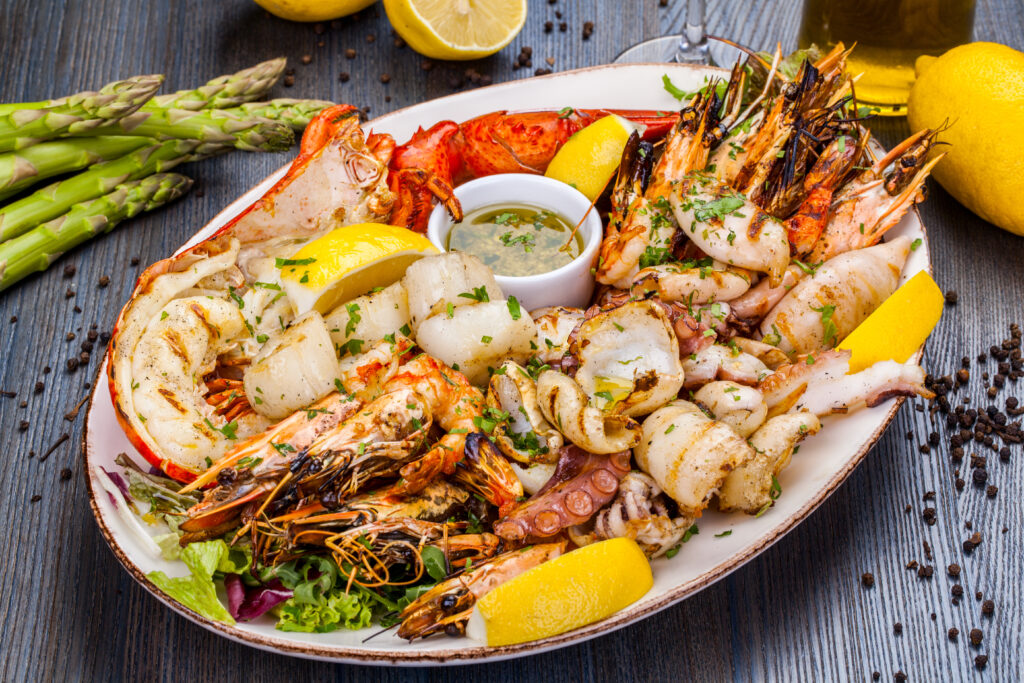Certain seafoods are halal, but many of them are not tayyib (pure, healthy)

By Mohammad Abdullah
September/October 2022
Turkiye’s Religious Affairs Directorate (Diyanet) fatwa of Aug. 26, 2021, advised that eating mussels, crabs, lobsters and shrimp is, according to the Hanafi school, is haram. Hyderabad-based Jamia Nizamia’s fatwa of January 2018 asked Muslims to avoid eating prawns, crabs and shrimp.
Muslim scholars are unanimous that whatever lives in water and dies when taken out of it are halal. However, Imam Abu Hanifa held that fish without scales are haram. Shias allow the eating of fish with scales and all water creatures except for edible crustaceans (i.e., shrimp, except crab) that are also halal; fish without scales are haram.
Quran 5:96 and 35:12 allow one to eat seafood. Abu Hurayra (radi Allahu ‘anhu) reported that the Prophet (salla Allahu ‘alayhi wa sallam), when asked about using seawater for ablution, responded, “Its water is pure and its dead (animals) are lawful (i.e., they can be eaten without any prescribed slaughtering).” Tirmidhi [69] calls it hassan sahih, and Bukhari says it’s sahih (“Sunan an-Nasa’i,” v.5, book 42, hadith no. 4355).
However, Jabir Ibn Abdullah (radi Allahu ‘anhu) narrates from the Prophet, “What the sea throws up and is left by the tide you may eat. But what dies in the sea and floats you must not eat” (“Sunan Abi Dawud,” v.2, p.176).
What Are Shellfish?
“Shell,” derived from the Latin word sella (seat), refers to creatures that sit on their shells when not swimming (e.g., prawns, crabs, lobsters and oysters).
Whether they are halal or haram depends on who you ask. The Hanafis consider all shellfish haram, whereas the Shafi’is, Malakis and Hanbalis consider almost all fish and shellfish that live in water and die quickly once out of it halal.
Mark 7:18-23 (ESV) records Jesus (‘alayhi as salam) as declaring all foods clean. However, many Bible scholars contend that the story, mentioned in both Matthew and Mark, is erroneous because both passages have nothing to do with food. When Mark 7, Matthew 15 and Acts 10-11 are analyzed together, other problems arise.
The Old Testament’s dietary laws include prohibitions against pork, shrimp and shellfish (Leviticus 11).
This article isn’t about what the relevant fatwas say, but about increasing the consumers’ awareness regarding water pollution, its effects on shellfish and the environment from which they are harvested.
Water Pollution
Water pollution occurs when harmful substances — often chemicals or microorganisms — contaminate any body of water, thereby degrading its quality and rendering it toxic to humans or the environment.
In her article for the Natural Resources Defense Council, freelance writer and editor Melissa Denchak wrote that 80% of ocean pollution originates on land. Contaminants such as chemicals, nutrients and heavy metals are carried from farms, factories and cities by streams and rivers into our bays and estuaries; from there they travel out to sea.
A CBS News report’s (January 2016) global analysis of seafood found that the oceans’ fish populations, regardless of location and species, are contaminated with industrial and agricultural pollutants, collectively known as persistent organic pollutants (POPs).
The Surfrider Foundation states that approximately 25% of U.S. households are still serviced by septic disposal systems, a figure that rises to nearly 50% in some states, especially in rural areas. The effluent that eventually reaches coastal waters is heavily polluted with nitrogen and some phosphorus.
According to the March 2022 Environmental Protection Agency (EPA) surveys, nearly half of our rivers and streams and more than one-third of our lakes are polluted and unfit for swimming, fishing and drinking.
The March 2022 report of the Environmental Integrity Project, established by former EPA enforcement attorneys, recommends that Congress strengthen the Clean Water Act by closing its loophole for agricultural runoff and other “non-point” sources of pollution — by far the largest sources of impairments in this country’s waterways.
Improperly treated or controlled farm manure and agricultural chemicals can end up in waterways and impact shellfish growing areas. Sewage from malfunctioning or aging treatment plants, along with the failure of home septic systems, can release human waste and other dangerous bacteria and pathogens into these areas.
My Master of Public Health research project at Harvard University School of Public Health’s Department of Environmental Health analyzed sewage from food production plants. Meat and poultry plants, depending on their size, can generate significant amounts of solid waste and sewage. However, this waste pales in comparison with the enormous amount of farm-produced animal waste. The risk continues to grow as large-scale animal feeding operations proliferate.
Public Health Issues
Shellfish feed by filtering the water that washes over their beds and passes through their bodies to get food. The world’s coastal areas from which they may be harvested are highly polluted. Public health officials and fisheries departments periodically warn that certain shellfish may be contaminated with pathogenic viruses and bacteria. Traditionally, one didn’t eat shellfish during the warmer months because they were frequently subjected to microbial contamination.
For example, the FDA warned on April 4 that Canadian oysters were linked to a norovirus outbreak that had sickened hundreds and were harvested from very polluted places. Norovirus, a highly contagious virus that can cause viral gastroenteritis and is often called “food poisoning” or the “stomach flu,” is usually caused by eating raw or partially cooked shellfish. Norovirus enters seawater through untreated human sewage that may come from leaky septic systems, faulty wastewater treatment plants, boaters or beachgoers.
The Washington State Department of Health writes that vibrio bacteria naturally lives in the warm tidal waters where oysters grow. Because oysters feed by filtering water, vibrio and other harmful bacteria and viruses can concentrate in their tissues.
Vibriosis is a bacterial infection caused by eating raw oysters. According to the CDC’s webpage, individuals with medical conditions may be at a high risk of becoming seriously ill and even dying by eating raw or undercooked shellfish. Most vibrio infections from oysters result in only diarrhea and vomiting. However, infections caused by vibrio vulnificus can lead to bloodstream infections, severe blistering skin lesions and other more severe illnesses. Many people with V. vulnificus infections require intensive care or limb amputations; 15-30% of the infections are fatal. Vibrio bacteria naturally live in the warm tidal waters where oysters grow
Shellfish harvested from polluted water sources and inadequately cooked can give you hepatitis A. According to the EPA, shellfish from some polluted coastal areas may cause birth defects, liver damage, cancer and other serious health problems.
The National Center for Biotechnology Information reports that the main potential food safety hazards in shrimp farming are zoonoses, chemical contamination, food allergens, heavy metals and veterinary drug residues (https://pubmed.ncbi.nlm.nih.gov). Yet another report states that imported shrimp, more than any other, are contaminated with banned chemicals, pesticides and even cockroaches. The number one reason for all that is the dirty conditions in which farmed shrimp are raised.
Water pollution may not damage our health immediately, but it clearly can be harmful in the long term.
Monitoring and Inspection
Coastal American states routinely monitor shellfish harvest waters for pollution. The Bureau of Public Health oversees the application of the National Shellfish Sanitation Program. When contaminant levels are unsafe, fish and shellfish advisories help people make informed decisions about where to fish or harvest shellfish. EPA advisories recommend that people limit or avoid eating certain species of fish and shellfish caught in certain places. And finally, the FDA is responsible for ensuring that the nation’s seafood supply, both domestic and imported, is safe, sanitary, wholesome and honestly labeled — except for farmed catfish, which is inspected by the USDA.
Municipal and industrial activities wastewater is a major source of coastal water pollution that threatens the world’s coastal habitats and fisheries. Wastewater pollution also threatens human health through the consumption of contaminated seafood, particularly in communities that are highly dependent on seafood. Addressing this, in combination with other efforts to support and sustain vital coastal fisheries, can improve outcomes for fisheries’ health, food security and human health.
There are some genuine concerns about water pollution. Foremost is the lack of national standards for animal waste management at the farm level and the monitoring of septic tank systems. The frequency of monitoring by local and state water and sewage authority in some states is believed to be inadequate in certain areas. Moreover, trans-jurisdiction issues between the FDA and the USDA not only endanger the public, but also are clearly not the best utilization of the available resources.
Cleanliness In Islam
Polluting water contradicts Islam’s teachings. As one hadith states, “People are partners in three things: Water, grass of pasture and fire” (“Sunan Abi Dawud”). Jabir also narrated that the Prophet forbade urinating in standing water (“Sahih Muslim”).
Cleanliness, an integral element of Islam, is mentioned throughout the Quran, which emphasizes eating only halal, tayyib (pure, healthy) food. Thus, impure things remain impure, even if they weren’t specifically prohibited. According to Islamic scholars, “for a thing to be pure,
it should be noted that all those things are pure which are not unclean according to any principle of the Islamic Law, or which are not offensive to good taste or have not universally been regarded as repugnant by cultured people” (Maududi, Tafhim al-Qur’an [The Meaning of the Qur’an], Vol.1, Surah Al-Ma’idah, item # 18, p. 19). This is important because what an animal eats largely determines whether it’s clean enough to eat. Fish with scales generally eat plants or other fish, whereas shellfish are bottom dwellers scavengers that eat a lot of dead things.
Consumers of shellfish, including oysters, should cook the item until it reaches an internal temperature of at least 145°F, as quick steaming isn’t sufficient to kill norovirus. Moreover, an oyster that contains harmful bacteria doesn’t look, smell or even taste different from any other oyster.
How You Can Help
If you use a septic tank, learn how your septic system works and keep it properly maintained. Scoop your pet’s poop, bag it and place it in the trash. If you’re a boater, manage your sewage wastes properly. Dispose of unused medicine and chemicals properly and never dump them into household toilets and sinks or outside, where they can get into ditches or storm drains. And, see if your community has a household hazardous waste drop-off facility that will take your old or unused chemicals.
Mohammad Abdullah, DVM, MS, MPH, retired as deputy district manager at USDA-FSIS.
Tell us what you thought by joining our Facebook community. You can also send comments and story pitches to horizons@isna.net. Islamic Horizons does not publish unsolicited material.
